A Dictionary of Music and Musicians/Appoggiatura
APPOGGIATURA. (Ital. from appoggiare, to lean upon; Ger. Vorschlag, Vorhalt; Fr. Port de voix.) One of the most important of melodic ornaments, much used in both vocal and instrumental compositions. It consists in suspending or delaying a note of a melody by means of a note introduced before it; the time required for its performance, whether long or short, being always taken from the value of the principal note. It is usually written in the form of a small quaver, semiquaver, or demisemiquaver, either with or without a stroke across the stem (Ex. 1).
The appoggiatura may belong to the same harmony as the principal note (Ex. 2), or it may be one degree above or below it. In the latter case it is a so-called 'auxiliary note' (sometimes called 'transient' or 'changing' note— Wechselnote), and follows the known rule of such notes, that the lower auxiliary note should be only one semitone distant from the principal note, the upper being either a tone or a semitone according to the scale (Ex. 3).

With regard to its length, the appoggiatura is of two kinds, long and short; the long appoggiatura bears a fixed relation to the length of the principal note, as will be seen presently, but the short one is performed so quickly that the abbreviation of the following note is scarcely perceptible. There is also a difference between the two kinds in the matter of accent; the long appoggiatura is always made stronger than the principal note, while in the case of the short one the accent falls on the principal note itself (Ex. 4).

On this subject authorities would seem to differ, Leopold Mozart, Hummel, and others holding the view advanced above, while Emanuel Bach, Marpurg, and Agricola give the rule that all appoggiaturas should be accented. It is however evident that a note which passes away so quickly as a short appoggiatura can scarcely receive any effective accent, and besides this it is doubtful whether the above-named writers may not have intended the rule to refer exclusively to the long appoggiatura (Vorhalt), as they often used the word Vorschlag for both kinds indiscriminately. Since then there is no accent on the short appoggiatura, the term itself, which means a note dwelt upon, seems inappropriate, and accordingly the word 'acciacatura' has been very generally substituted for it, though properly belonging to another similar kind of ornament. (See Acciaccatura.)
The rules relating to the length of the long appoggiatura are three, and are thus given by Türk in his 'Clavierschule':—'Whenever it is possible to divide the principal note into two equal parts, the appoggiatura receives one half' (Ex. 5). 'When the principal note is dotted the appoggiatura receives two-thirds and the principal note one' (Ex. 6). If the principal note is tied to another shorter note, the appogiatura receives the whole value of the principal note' (Ex. 7). The third rule is commonly though not invariably followed when the principal note is followed by a rest (Ex. 8).
5. Mozart, Sonata in A minor.

6. Hummel, 'Pianoforte School.'

7. Bach, 'Passionsmusik.'

8. Beethoven, 'Adelaide.'

Exceptions to the above rules are met with as follows:—to the first and second rules in Bach and Mozart, who frequently employed an appoggiatura (called by Marpurg 'der kürzeste Vorhalt') which was worth one third or less of the principal note, but which differed from the short appoggiatura in being accented (Ex. 9). An exception to the second rule occurs whenever its strict observance would occasion a fault in the harmonic progression (Ex. 10), or when it would interfere with the rhythmic regularity of the passage (Ex. 11). Exceptions to the third rule are of still more frequent occurrence; many passages containing a tied note preceded by an appoggiatura would entirely lose their significance if the rule were strictly adhered to. Taste and experience alone can decide where similar exceptions are admissible.
In the works of some of the earlier composers an appoggiatura is occasionally, though very rarely, to be met with, which although placed before a note capable of being halved, yet receives three-fourths of its value. This appoggiatura was usually dotted (Ex. 12).
9. Bach, 'Passionsmusik.'

Mozart, Fantasia in C minor.
![{ \time 4/4 \partial 4. << \relative g' { r32 gis[ b a] cis[ b d cis] e[ d fis e] | \appoggiatura g8 fis4 fis8 fis \bar "||" }
\new Staff { \clef treble \relative g'' { s4. | \times 2/3 { g16 fis ~ fis ~ } fis8 fis fis } } >> }](http://upload.wikimedia.org/score/0/8/081znzfx2u9bwrcigz714734teqws3p/081znzfx.png)
10. Bach, 'Suites Françaises.'

11. Schubert, Rondo, Pianoforte and Violin.


The appoggiatura, whether long or short, is always included in the value of the principal note; if therefore it is applied to a chord it delays only the note to which it belongs, the other notes of the chord being played with it (Ex. 13).
13. Beethoven, Andante in F.
![{ \time 3/8 \key f \major << \relative g' { <g d>8 ~ <g d>16. <a fis c>32 \appoggiatura c16 <bes g d>16. <g d>32 \bar "||" s8 }
\new Staff { \key f \major \relative c'' << { s4 \times 2/3 {c32[ bes ~ bes] ~ } bes[ g] | s8 } \\ { s4 <g d>16. d32 } >> } >> }](http://upload.wikimedia.org/score/3/5/35eielpje220uj25rfl02vncezbu8s9/35eielpj.png)
Mozart, Sonata in F.

The manner of writing the appoggiatura bears no very definite relation to its performance, and its appearance is unfortunately no sure guide as to its length. In music of the 17th century, at which period the short appoggiatura appears to have first come into use, it was customary to make use of certain signs (Ex. 14), but as after a time the long appoggiatura was introduced, these were given up in favour of the small note still used. This small note ought always to be written of the exact value which it is to bear, if a long appoggiatura (Ex. 15); or if a short one it should be written as a quaver or semiquaver with a short stroke across the stem in the opposite direction to the hook (Ex. 16).[1]
![{ \override Score.TimeSignature #'stencil = ##f \time 3/4 \override Score.Clef #'stencil = ##f \relative f'' { f4^\markup { 14. \italic Written. } <d>-\tweak #'X-offset #0 -\tweak #'Y-offset #1.5 -\stopped b-\tweak #'X-offset #0 -\tweak #'Y-offset #0.5 -\stopped \bar "|" f' d b \bar "|" f'\glissando d\glissando b \bar "||" f'^\markup { \italic Played. } e16[ d8.] c16[ b8.] \bar "|" } }](http://upload.wikimedia.org/score/a/n/anv8wapapqgy92r2r6b39jppefhi0z9/anv8wapa.png)

But the earlier writers often wrote the short appoggiatura as a semiquaver or demisemiquaver without the stroke, and in many new editions of old compositions we find the small note printed with the stroke even where it should be played long, while in modern music the semiquaver without the stroke is often met with where the short appoggiatura is obviously intended. In this uncertainty the surest guide is the study of the treatment of the appoggiatura by the great masters in the numerous cases in which they have written it out in notes of the ordinary size (see Beethoven, Bagatelles, Op. 119, No. 4, Bar
2; Mozart, Sonata in C, Halle's edition, No. 6, Bar 37, &c.), as by analogy we may hope to arrive at some understanding of their intentions respecting it when we find it merely indicated by the small note.
The following series of examples of the conditions under which the several kinds of appoggiatura are most commonly met with, may also be of service in the same direction.
The appoggiatura is short when used before two or more repeated notes (Ex. 17), before detached or staccato notes (Ex. 18), or leaps (Ex. 19), at the commencement of a phrase (Ex. 20), and before groups containing dotted notes in somewhat quick tempo (Ex. 21).
17. Beethoven, Septett.

18. Mozart, Sonata in C.

19. Mozart, Sonata in C.

20. Mozart, Sonata in A minor.

21. Hummel, Op. 55.

In triplets, or groups of four or more equal notes, the appoggiatura is short (Ex. 22), except in groups of three notes in slow triple time (Ex. 23). The appoggiatura at a distance from its principal note is short (Ex. 24), except sometimes in slow cantabile passages (Ex. 25). Appoggiaturas occurring in a melody which ascends or descends by diatonic degrees are moderately short (Ex. 26), as are also those which occur in a melody descending by thirds (Ex. 27). Emanuel Bach says of these—'when the appoggiaturas fill up leaps of a third in the melody they are certainly short, but in adagio their expression should be smoother, as though representing one of a triplet of quavers rather than a semiquaver.' Türk calls them 'undecided
appoggiaturas.'
22. Beethoven, 'Bagatelles,' No. 1.

Op. 22.

23. Mozart, 'Don Giovanni.'

24. Haydn, Sonata in E♭.

25. Mozart, 'Requiem.'

26. Bach, Passepied in B.

27. Mozart, Rondo in D.

In groups of two equal notes the appoggiatura is long if in slow tempo or at the end of a phrase (Ex. 28); if otherwise, short (Ex. 29).
28. Graun, 'Der Tod Jesu.'

29. Hummel, 'Pianoforte School.'

When applied to the last note but one of a final cadence the appoggiatura should, according to Emanuel Bach, be short. But later composers have usually preferred the long appoggiatura under these circumstances, especially when accompanied by the seventh of the chord (Ex. 30), or by a part moving in sixths with it (Ex. 31). Beethoven has even lengthened it beyond the value of the principal note, but in this case it is always written as an ordinary note (Ex. 32). When however, in Haydn, Mozart, and all later composers, the final note of the cadence is anticipated, the appoggiatura to the preceding note is short (Ex. 33).
30. Mozart, First Mass.

31. Haydn, Symphony in E♭.

32. Beethoven, Op. 30, No. 3.
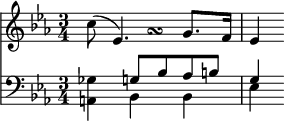
33. Mozart, Sonata in F.
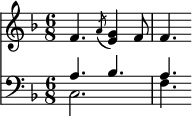
In vocal recitative, at the close of a phrase, or of a section of a phrase, an appoggiatura is often introduced which has the full value of the principal note, and indeed appears in its stead (Ex. 34); such an appoggiatura is often not indicated, but is left to the discretion (or want of discretion) of the singer (Ex. 35). It is more appropriate at the close of the whole recitative than after its component phrases, and is especially so when the melody descends a third or a fourth (Ex. 36).
34. Weber, 'Der Freischütz.'
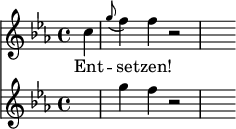
35. Haydn, 'The Seasons.'

36. Bach, 'Passionsmusik.'

Handel, 'Messiah.'
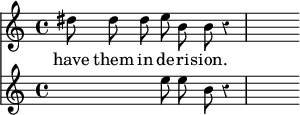
When a trill or other ornament appears in combination with an appoggiatura, the latter is long, and the trill is performed on the principal note or on the appoggiatura, according as it is placed above the one or the other (Ex. 37).
| 37. Haydn, Sonata in F. | Türk. |
 |
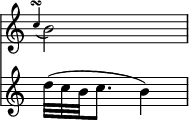 |
| [Time signature changed per App. p.523.] |
The proper execution of the appoggiatura seems to be most doubtful in the group in which the note bearing the appoggiatura is followed by two or four notes of half its own value. In the majority of such cases the appoggiatura should be long (Ex. 38), and particularly in smoothly flowing passages in moderate or slow tempo (Ex. 39). But there are numerous exceptions, as for example when the employment of the long appoggiatura would alter the rhythm of the passage (Ex. 40), or when (according to Türk) only a single example is present (Ex. 41).
38. Beethoven, Op. 10, No. 3.

Mozart, Sonata in D.

39. Mozart, Sonata in C, Andante.

40. Weber, 'Der Freischütz.'

41. Türk.

[ F. T. ]